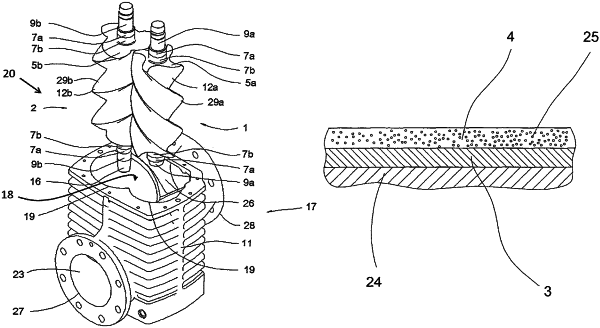| CPC F04C 18/16 (2013.01) [F04C 18/084 (2013.01); F04C 27/009 (2013.01); F04C 2230/91 (2013.01); F04C 2240/20 (2013.01); F04C 2240/30 (2013.01); F04C 2240/50 (2013.01)] | 20 Claims |

|
1. A screw compressor comprising:
a compressor housing;
two rotor screws mounted axially parallel in the compressor housing, the two rotor screws meshing with each other in a compression space and synchronized with each other in their rotational movement; and
a drive in communication with the two rotor screws to rotate the rotor screws;
wherein each of the rotor screws comprises a single-part or multi-part base body with two end faces and a profiled surface extending therebetween and shaft ends projecting beyond the end faces, each of the shaft ends comprising a bearing seat and seal seats between the bearing seat and the end face;
wherein:
each profiled surface is coated with a first layer and the first layer is coated with a second layer, wherein the first layer and the second layer both comprise a thermoplastic synthetic material; and
each of the seal seats is coated with only the first layer; and wherein particles or pores supporting a running-in process are embedded in the second layer and the thermoplastic synthetic material defines a matrix for receiving the particles or for forming the pores, respectively.
|
|
6. A method for applying a multilayer coating to surfaces of a rotor screw of a screw compressor, the method comprising:
applying a first layer of a first thermoplastic synthetic material to a profiled surface of the rotor screw, the rotor screw comprising a single-part or multi-part base body with two end faces and the profiled surface extending therebetween and shaft ends projecting beyond the end faces, each of the shaft ends comprising a bearing seat and seal seats between the bearing seat and the end face;
coating the first layer of synthetic material on the profile surface with a second layer of a second thermoplastic synthetic material;
applying only the first layer of the first thermoplastic synthetic material to each of the seal seats of the rotor screw;
wherein particles or pores supporting a running-in process are embedded in the second layer and the second thermoplastic synthetic material defines a matrix for receiving the particles or for forming the pores, respectively.
|
|
11. A screw compressor comprising:
a compressor housing;
two rotor screws mounted axially parallel in the compressor housing, the two rotor screws meshing with each other in a compression space and synchronized with each other in their rotational movement; and
a drive in communication with the two rotor screws to rotate the rotor screws; wherein:
each profiled surface is coated with a first layer and the first layer is coated with a second layer, wherein the first layer and the second layer both comprise a thermoplastic synthetic material; and
each of shaft ends comprising a bearing seat, each of the bearing seats is uncoated;
wherein particles or pores supporting a running-in process are embedded in the second layer and the thermoplastic synthetic material defines a matrix for receiving the particles or for forming the pores, respectively.
|
|
16. A method for applying a multilayer coating to surfaces of a rotor screw of a screw compressor, the method comprising:
applying a first layer of a first thermoplastic synthetic material to a profiled surface of the rotor screw, the rotor screw comprising a single-part or multi-part base body with two end faces and the profiled surface extending therebetween and shaft ends projecting beyond the end faces, each of the shaft ends comprising a bearing seat and seal seats between the bearing seat and the end face;
coating the first layer of synthetic material on the profile surface with a second layer of a second thermoplastic synthetic material; and
maintaining each of the bearing seats uncoated by either the first layer or the second layer;
wherein particles or pores supporting a running-in process are embedded in the second layer and the second thermoplastic synthetic material defines a matrix for receiving the particles or for forming the pores, respectively.
|